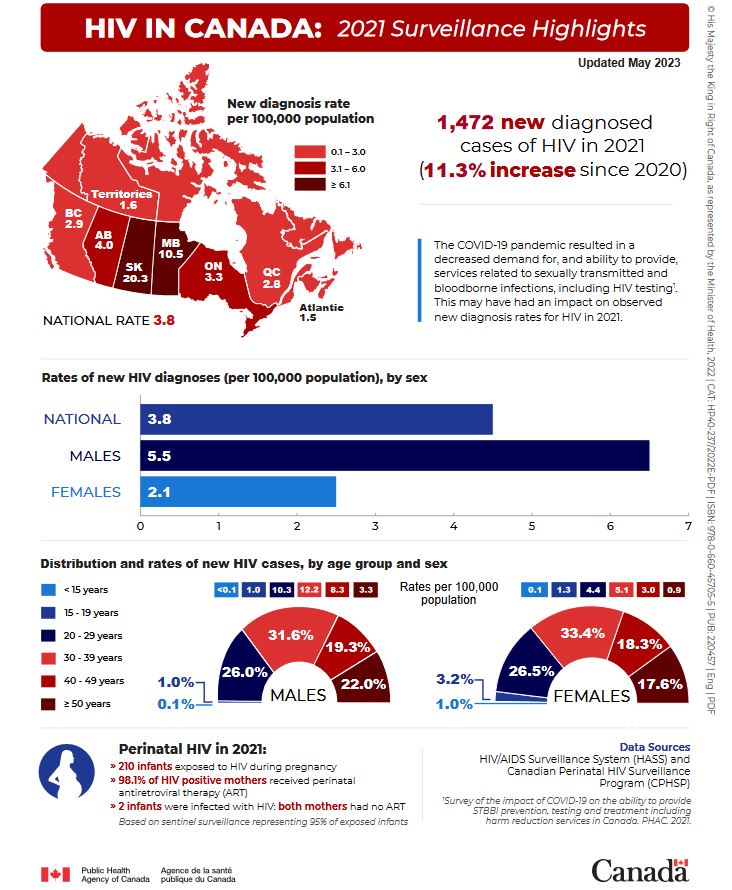HIV in Canada: 2021 surveillance highlights
Download in PDF format
(260 KB, 1 page)
Organization: Public Health Agency of Canada
Type: Infographic
Date published: 2021
ISBN: 978-0-660-45705-5
From: Public Health Agency of Canada
- 1,472 new diagnosed cases of HIV in 2021 (11.3% increase since 2020)
- National rate of new HIV diagnoses for 2021 - 3.8 per 100,000 population
- Rate of new HIV diagnoses in males - 5.5 per 100,000 population
- Rate of new HIV diagnoses in females - 2.1 per 100,000 population
2021 Data notes
- The COVID-19 pandemic resulted in a decreased demand for, and ability to provide, services related to sexually transmitted and bloodborne infections, including HIV testing.Footnote 1 This may have had an impact on observed new diagnosis rates for HIV in 2021.
New diagnosis rate per 100,000 population in 2021
- National HIV diagnosis rate - 3.8
- Provincial and territorial HIV diagnosis rates:
- Territories - 1.6
- British Columbia - 2.9
- Alberta - 4.0
- Saskatchewan - 20.3
- Manitoba - 10.5
- Ontario - 3.3
- Quebec - 2.8
- Atlantic - 1.5
Distribution and rates of new HIV cases, by age group and sex
| Age Groups | Total | Male | Female | |||
|---|---|---|---|---|---|---|
| % | Rate | % | Rate | % | Rate | |
| Children < 15 years | 0.3 | 0.1 | 0.1 | <0.1 | 1.0 | 0.1 |
| 15-19 | 1.6 | 1.2 | 1.0 | 1.0 | 3.2 | 1.3 |
| 20-29 | 26.4 | 7.6 | 26.0 | 10.3 | 26.5 | 4.4 |
| 30-39 | 32.1 | 8.8 | 31.6 | 12.2 | 33.4 | 5.1 |
| 40-49 | 18.9 | 5.7 | 19.3 | 8.3 | 18.3 | 3.0 |
| 50+ | 20.6 | 2.0 | 22.0 | 3.3 | 17.6 | 0.9 |
Perinatal HIV in 2021
- 210 infants exposed to HIV during pregnancy
- 98.1% of HIV positive mothers received perinatal antiretroviral therapy (ART)
- 2 infants were infected with HIV; both mothers had no ART
- Based on sentinel surveillance representing 95% of exposed infants
Data sources
HIV/AIDS Surveillance System (HASS) and Canadian Perinatal HIV Surveillance System (CPHSP)
- Footnote 1
-
Survey of the impact of COVID-19 on the ability to provide STBBI prevention, testing and treatment including harm reduction services in Canada. PHAC. 2021.
